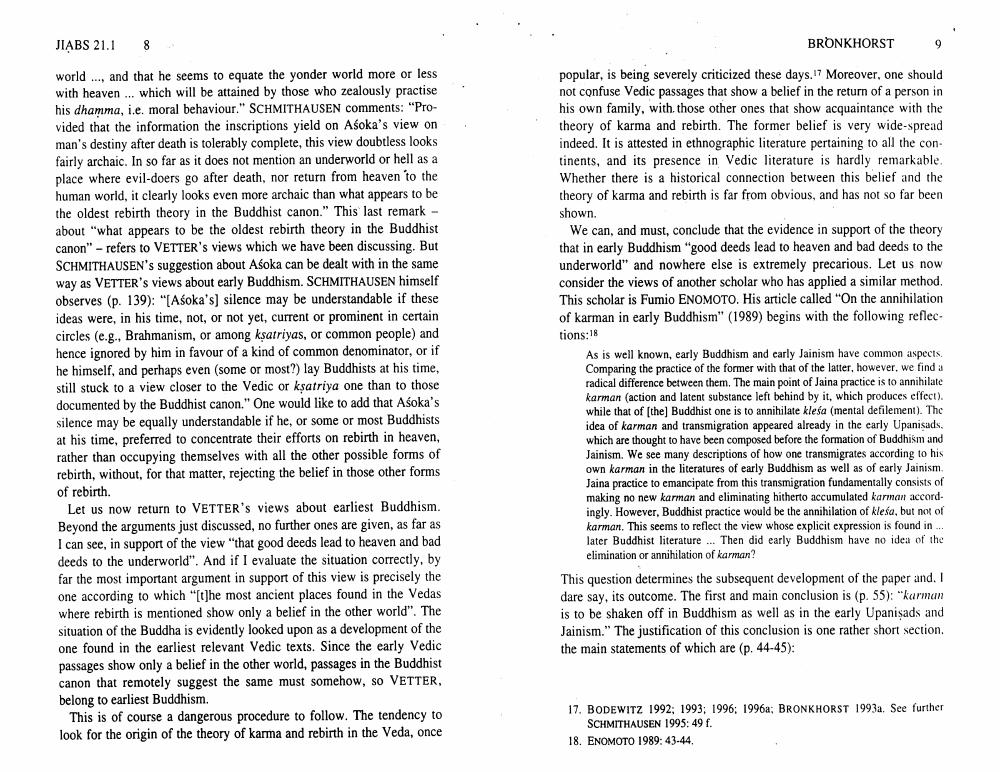Book Title: Did Buddha Believe In Karma And Rebirth Author(s): Johannes Bronkhorst Publisher: Johannes Bronkhorst View full book textPage 5
________________ JIABS 21. 1 8 BRONKHORST 9 world .... and that he seems to equate the yonder world more or less with heaven ... which will be attained by those who zealously practise his dhamma, i.e. moral behaviour." SCHMITHAUSEN comments: "Provided that the information the inscriptions yield on Asoka's view on man's destiny after death is tolerably complete, this view doubtless looks fairly archaic. In so far as it does not mention an underworld or hell as a place where evil-doers go after death, nor return from heaven to the human world, it clearly looks even more archaic than what appears to be the oldest rebirth theory in the Buddhist canon." This last remarkabout "what appears to be the oldest rebirth theory in the Buddhist canon" - refers to VETTER's views which we have been discussing. But SCHMITHAUSEN's suggestion about Asoka can be dealt with in the same way as VETTER's views about early Buddhism. SCHMITHAUSEN himself observes (p. 139): "[Asoka's) silence may be understandable if these ideas were, in his time, not, or not yet, current or prominent in certain circles (e.g., Brahmanism, or among ksatriyas, or common people) and hence ignored by him in favour of a kind of common denominator, or if he himself, and perhaps even (some or most?) lay Buddhists at his time, still stuck to a view closer to the Vedic or ksatriya one than to those documented by the Buddhist canon." One would like to add that Asoka's silence may be equally understandable if he, or some or most Buddhists at his time, preferred to concentrate their efforts on rebirth in heaven, rather than occupying themselves with all the other possible forms of rebirth, without, for that matter, rejecting the belief in those other forms of rebirth. Let us now return to VETTER's views about earliest Buddhism. Beyond the arguments just discussed, no further ones are given, as far as I can see, in support of the view that good deeds lead to heaven and bad deeds to the underworld". And if I evaluate the situation correctly, by far the most important argument in support of this view is precisely the one according to which "[t]he most ancient places found in the Vedas where rebirth is mentioned show only a belief in the other world". The situation of the Buddha is evidently looked upon as a development of the one found in the earliest relevant Vedic texts. Since the early Vedic passages show only a belief in the other world, passages in the Buddhist canon that remotely suggest the same must somehow, so VETTER, belong to earliest Buddhism. This is of course a dangerous procedure to follow. The tendency to look for the origin of the theory of karma and rebirth in the Veda, once popular, is being severely criticized these days.!7 Moreover, one should not confuse Vedic passages that show a belief in the return of a person in his own family, with those other ones that show acquaintance with the theory of karma and rebirth. The former belief is very wide-spread indeed. It is attested in ethnographic literature pertaining to all the continents, and its presence in Vedic literature is hardly remarkable Whether there is a historical connection between this belief and the theory of karma and rebirth is far from obvious, and has not so far been shown. We can, and must, conclude that the evidence in support of the theory that in early Buddhism "good deeds lead to heaven and bad deeds to the underworld" and nowhere else is extremely precarious. Let us now consider the views of another scholar who has applied a similar method. This scholar is Fumio ENOMOTO. His article called "On the annihilation of karman in early Buddhism" (1989) begins with the following reflections:18 As is well known, early Buddhism and early Jainism have common aspects. Comparing the practice of the former with that of the latter, however, we find a radical difference between them. The main point of Jaina practice is to annihilate karman (action and latent substance left behind by it, which produces effect). while that of [the] Buddhist one is to annihilate klesa (mental defilement). The idea of karman and transmigration appeared already in the early Upanisads. which are thought to have been composed before the formation of Buddhism and Jainism. We see many descriptions of how one transmigrates according to his own karman in the literatures of early Buddhism as well as of early Jainism Jaina practice to emancipate from this transmigration fundamentally consists of making no new karman and eliminating hitherto accumulated karmant accordingly. However, Buddhist practice would be the annihilation of kleša, but not of karman. This seems to reflect the view whose explicit expression is found in ... later Buddhist literature ... Then did early Buddhism have no idea of the elimination or annihilation of karman? This question determines the subsequent development of the paper and. I dare say, its outcome. The first and main conclusion is (p.55): "kurman is to be shaken off in Buddhism as well as in the early Upanisads and Jainism." The justification of this conclusion is one rather short section. the main statements of which are (p. 44-45): 17. BODEWITZ 1992; 1993; 1996: 1996a; BRONKHORST 1993a. See further SCHMITHAUSEN 1995: 49 f. 18. ENOMOTO 1989: 43-44.Page Navigation
1 ... 3 4 5 6 7 8 9 10
